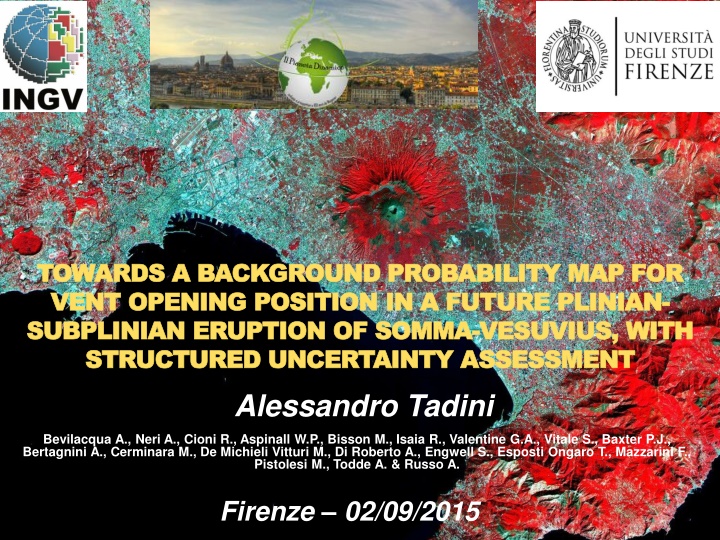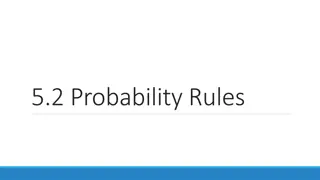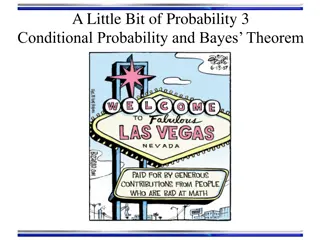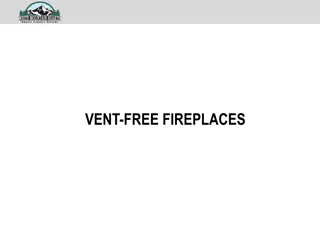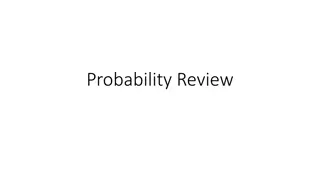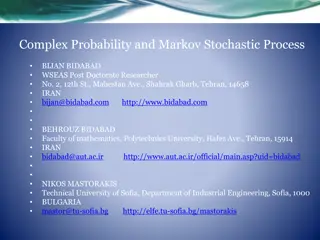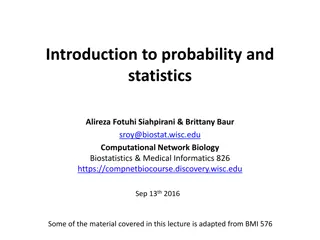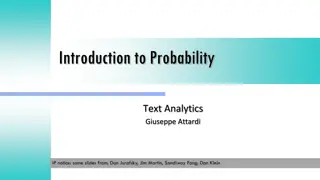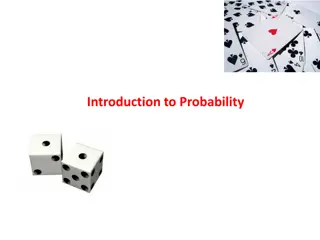Background Probability Map for Plinian Vent Opening Position
A study presents a background probability map for future Plinian and Subplinian vent opening positions at Somma-Vesuvius (SV) caldera, addressing uncertainties and expert judgments. The research outlines datasets, spatial uncertainties, and morphological constraints, offering insights into the distribution of volcanic eruptions within and outside the caldera. Various variables like eruption types, parasitic vents, and deep faults are considered to create vent opening probability maps for SV.
Download Presentation

Please find below an Image/Link to download the presentation.
The content on the website is provided AS IS for your information and personal use only. It may not be sold, licensed, or shared on other websites without obtaining consent from the author.If you encounter any issues during the download, it is possible that the publisher has removed the file from their server.
You are allowed to download the files provided on this website for personal or commercial use, subject to the condition that they are used lawfully. All files are the property of their respective owners.
The content on the website is provided AS IS for your information and personal use only. It may not be sold, licensed, or shared on other websites without obtaining consent from the author.
E N D
Presentation Transcript
TOWARDS A BACKGROUND PROBABILITY MAP FOR TOWARDS A BACKGROUND PROBABILITY MAP FOR VENT OPENING POSITION IN A FUTURE PLINIAN VENT OPENING POSITION IN A FUTURE PLINIAN- - SUBPLINIAN SUBPLINIAN ERUPTION OF ERUPTION OF SOMMA STRUCTURED UNCERTAINTY ASSESSMENT STRUCTURED UNCERTAINTY ASSESSMENT Alessandro Tadini SOMMA- -VESUVIUS, WITH VESUVIUS, WITH Bevilacqua A., Neri A., Cioni R., Aspinall W.P., Bisson M., Isaia R., Valentine G.A., Vitale S., Baxter P.J., Bertagnini A., Cerminara M., De Michieli Vitturi M., Di Roberto A., Engwell S., Esposti Ongaro T., Mazzarini F., Pistolesi M., Todde A. & Russo A. Firenze 02/09/2015
OUTLINE Datasets description Spatial uncertainties Probability density maps Vent opening probability maps with single datasets Structured Expert Judgement Preliminary vent opening probability map Effect of caldera enlargement in case of a Plinian eruption 2 SV vent opening probablity map
PRELIMINARY DEFINITIONS/ASSUMPTIONS Somma-Vesuvius (SV) Caldera Morphological constraints: Foot of Mt. Somma scarp (N-NE) Limit of Piano delle Ginestre and Valle dell Inferno (W-S-SW) Surface: 12.98 km2 Next Plinian/Subplinian eruption will reasonably take place within the SV caldera (past distribution of Explosive activity at SV is confined within this area) BUT Several episodes of volcanic activity (effusive) outside SV caldera (probability for next eruption to be placed outside SV caldera?) 3 SV vent opening probablity map
DATASETS FOR SV VENT OPENING PROBABILITY MAPS/1 8 datasets/variables Distribution of PLINIAN/SUBPLINIAN I-II eruptions PLINIAN eruptions (4 events 22 ky BP>Age>AD 79); SUBPLINIAN I-II eruptions (6 events 19 ky BP>Age>AD 1631); Distribution of VIOLENT STROMBOLIAN (VS) to CONTINUOUS ASH EMISSION (AE) eruptions; Within the whole SV caldera (22 ky BP>Age>3.9 ky BP) Within the Gran Cono area (22 events 3.9 ky BP>Age>AD 1631) Within the 1944 Crater Rim area (10 events AD 1631>Age>AD 1944) Distribution of EFFUSIVE eruptions (AD 1631>Age>AD 1944) Parasitic vents (46 mapped, 47 lost ); Eruptive fissures ( High-density area); Distribution of DEEP FAULTS (Quaternary? 3 faults crossing SV caldera); 1 Homogeneous distribution (Accounts for neglected factors and missing information) Each feature has been attributed an uncertainty area that reflect spatial uncertainties in feature location. Areas have been defined according to: Morphological constraints (Plinian eruptions) Temporal constraints/Field evidences (Subplinian eruptions, VS to AE eruptions, Effusive eruptions) Resolution limits of interpolation profiles (Deep Faults) 4 SV vent opening probablity map
DATASETS FOR SV VENT OPENING PROBABILITY MAPS/2 UNCERTAINTY AREAS PLINIAN SUBPLINIAN VS to AE - CALDERA VS to AE GRAN CONO PARASITIC VENTS ERUPTIVE FISSURES DEEP FAULTS VS to AE 1944 CRATER 5 SV vent opening probablity map
PROBABILITY DENSITY FUNCTIONS: GAUSSIAN KERNELS/1 Variables can be used for the numerical generation of single probability distributions (PD) of vent opening (VO) obtained from them. VO maps were derived from the application of a Gaussian kernel to the uniform PD the resultant distribution will spread a small amount of probability outside the boundary of the uncertainty area as a function of the bandwidth chosen The bandwidths of the Gaussian kernels are: 1. for Plinian/Subplinian eruptions and Parasitic effusive vents the mean minimum distance between the centroids of the uncertainty areas; 2. for Deep faults an estimate of the average damage zone (DZ) width; 3. for VS to AE (Crater and Gran Cono) eruptions and Eruptive fissures a fixed value of 100 m (the cell size). 6 SV vent opening probablity map
PROBABILITY DENSITY FUNCTIONS: GAUSSIAN KERNELS/2 7 SV vent opening probablity map
STRUCTURED EXPERT JUDGEMENT Three different judgement scoring procedures have been applied to the elicitation data: Classical Method (CM), Expected Relative Frequency method (ERF), and Equal Weights rule (EW). CM and EW metrics assume the experts central values are the median values of maximum entropy distributions, while ERF assumes they are modal values of triangular distributions. 17 Experts were invited to provide their judgements on 16 seed items for calibration scoring purposes. For calculating location uncertainty estimates, the different decision maker assessments were implemented in a logic tree structure for the target questions through Monte Carlo simulation. Each expert responded to 15 target items for providing weights that needs to be attributed the different VO maps related to previous variables. 6-10% Sensitivity analyses were performed by removing controversial seed questions and by considering sub-groups of experts (Juniors/Seniors, Geologists/Modelers) Agreement between weights/maps among different scoring procedures and different sub-groups (weights differ maximum for 3%) CM maps with all the experts considered as a reference 8 SV vent opening probablity map
PRELIMINARY VENT OPENING PROBABILITY MAPS Mean 5th 95th 5th Mean 95th Maxima located in correspondence of the present Crater (values range from 0.17% up to 0.4%) More pronunced effect of Deep Faults on mean map and 95th percentile map (effect of high skeweness toward higher values of weight attributed to this dataset by the experts) Values of probabilities for different caldera sectors Sector A (Gran Cono): 43.9% Sector B (Valle del Gigante): 15.7 % Sector C (Valle dell Inferno): 10.8 % Sector D (Piano delle Ginestre): 29.6 % 9 SV vent opening probablity map
CALDERA ENLARGEMENT Possible caldera enlargement are due to the occurence of a Plinian eruption (probability that the next SV eruption is a Plinian one is 8.16% - see Neri et al. 2008) The previous CM mean map has been applied a special kernel function ( Pencil collapse ) made by a circle with 1.3 km of radius (mean radius of past Plinian eruption collapsed areas) where the distribution of probability is 60% from the middle up to 0.25 km, 5% from 0.25 km to 1.05 km and 35% from 1.050 km to 1.3 km. This special function reproduces the migration of volcanic vent during Plinian eruption at SV from the INITIAL VENT of the eruption in the middle up to the limit of the collapsing areas Mean map on the left has been obtained by combining a CM mean map without caldera enlargement (that accounts for 92.84% of the weight) with a mean map that has been applied a caldera enlargement (that accounts for 8.16% of the weight) This map represent a Preliminary vent opening probability map with also the probability of caldera enlargement conditional to the occurrence of a medium-large size eruption at SV Probabilities of caldera enlargement are 1.5% (around 13% if the next eruption is a Plinian one): 0.73% toward N/NE, 0.31% toward S/SE and 0.43% toward W/NW. No caldera enlargement are expected in case of a Sub-Plinian or lower magnitude eruption 10 SV vent opening probablity map
CONCLUSIONS AND FUTURE DEVELOPMENTS Development of a geodatabase with distribution of past volcanic activity and structural features (Uncertainty areas) Probability Density Functions for single datasets (Kernel functions with appropriate bandwidths) Structured Expert Judgement for weights assignements to different datasets (different scoring methods CM, ERF, EW) Sensitivity analyses with sub-groups of experts (Juniors/Seniors, Geologists/Modelers) agreement among experts Preliminary vent opening probability map with caldera enlargement: Initial vent outside SV caldera from 6% to 10%, caldera enlargement with 1- 2% of probability Revision of SV caldera enlargement Calculation of new parameters (TGSD and Volume) for two Eruptive Units (EU3pf and EU4) from the AD 79 Plinian eruption Use of new parameters for numerical modelling of PDCs to produce invasion maps that take into account Vent opening probability maps developed so far. 11 SV vent opening probablity map
